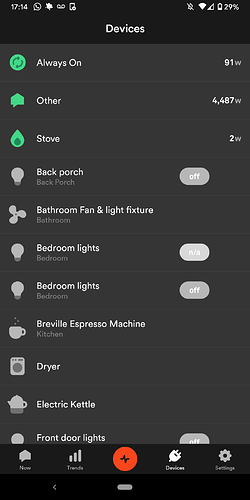Prefacing this by saying I love SENSE, and have enough enthusiasm about it to contribute as a Beta tester, but I need to get this off my chest.
There are plenty of users who have more knowledge and experience than I do. I would be grateful for any input you might have.
TLDR: Historical data leaves a lot to be desired from the moment that SENSE gets anything wrong, or an add-on integration needs to be reset. And it will get things wrong on occasion.
I’m not the first to complain about this, and now I understand exactly why its so frustrating.
One oversite by SENSE in its product and platform design is the lack of contingency, and reversibility. In my 8-months of using SENSE, this has lead to 2 irreversible problems, neither of which were the fault of me the user. Both have resulted in a loss of data by SENSE that was effectively forced onto me.
Why forced? Because I had no say in what happened, and in both cases SENSE said either ‘Its not possible to merge these identical duplicate devices that had to be re-created’, or ‘its not possible to reverse that auto-merge of devices by our algorithm, even if its completely false’. Both situations that should arguably already have re-mediation scenarios in place
Scenario 1: Philips Hue integration
The Philips Hue integration was one of the first things I enabled when I installed SENSE. For the most part, it has worked flawlessly. The few times I had problems, they were usually the result of mDNS(multicase/broadcast packets) being erroneously dropped on my local network. Usually solved by power cycling the Gateway or wifi AP.
That is until a few months ago, when Philips made a major change to its codebase for Hue Bridge API control. This killed the integration with SENSE at that time.
Once SENSE was able to update their code to address these changes, the only remediation presented was to REMOVE/DELETE the integration, and re-add it.
This seemed reasonable in the moment, until I was left with every one of my Hue ‘rooms’ listed in duplicate in SENSE. One as the active one, one as ‘not available’.
SENSE support advised me that merging the old devices (and their associated history) and the newly ‘created’ identical devices would be impossible.
What I’m left with is keeping these devices in duplicate if I want to retain the history in SENSE, or deleting them and loosing that historical usage.
But if this is the approach to integrations, why should I trust the longevity of any of the SENSE integrations, and the continuity of their historical use? Situations like this are predictable and should arguably have an easy path to resolution that doesn’t cause the customer to have to choose between a messy UI with duplicate new/old devices, or loosing that data.
Scenario 2: Auto-merged baseboard heaters into ‘Stove 1’. No way to reverse.
Around the same time that I installed SENSE, I started using MYSA electric baseboard thermostats in a few rooms of my home.
After the first month or two, SENSE had managed to detect most of the electric baseboards, and all three of the electric baseboards controlled by the MYSA thermostats because of their unique power-use profiles VS. the other baseboards.
In the case of the MYSA controlled baseboards, I labelled them and got to experience fairly accurate detection of each one for most of the last 6 months.
I specified in the device configuration settings: Unique identifiable names, defined them as ‘Electric Baseboard’, but left the ‘This is a guess’ toggle as ON, because device detection wasn’t perfect for any of them.
Fast forward to June 6th at 9:08am. SENSE notifies me that ‘Mysa Controlled Baseboard 2’ and ‘Mysa Controlled Baseboard 1’ have been combined into ‘Stove’.
As a result of this forced auto-merge:
- I loose the historical record of each of these two devices as they were recorded by SENSE
- I’m left with a ‘Stove’ device that is a 100% false detection
- And, according to support, there is no way to reverse this
Lets set aside speculation about the heuristics used by SENSE to make the decision to merge these devices (time of year, changes in power profile of my home with seasonal temperature changes, assumed probability of stove usage at certain times of the year, that these are heating elements, that I left ‘this is a guess’ toggle as ON, etc)…
The fact that a forced merger like this is irreversible, and that SENSE has not already designed in a way for users to specifically flag this type of scenario, is a pretty major problem to me as a user.
Particularly so because I read other posts in late 2019 from frustrated users with this complaint, which to some degree set my expectation low early on. This isn’t a new problem, its a nearly guaranteed constant that will be variable for ever home.
What I’m taking from this experience is that this problem occuring again is not an IF but a WHEN, and based on other peoples anecdotal past experience, it seems like I should expect it to get progressively worse as time passes.
It seems possible that this is due to increased ‘noise’ in the power profile of a given home. Noise that compounds its negative effect over time, and possibly diminishing the efficacy of the algorthmic detections.
But ‘noise’ and what causes it is a variable that will change constantly, if not only because of seasonal appliances. IE: AC units, multiple types of fixed and variable speed DC fans, and any other power blocks or devices that generally leak ‘noise’ into the electrical signature of a home.
I cant help but wonder if me starting to use DC fixed and variable speed fans nearly 24/7 for the last few months doesn’t have a role to play in this.
